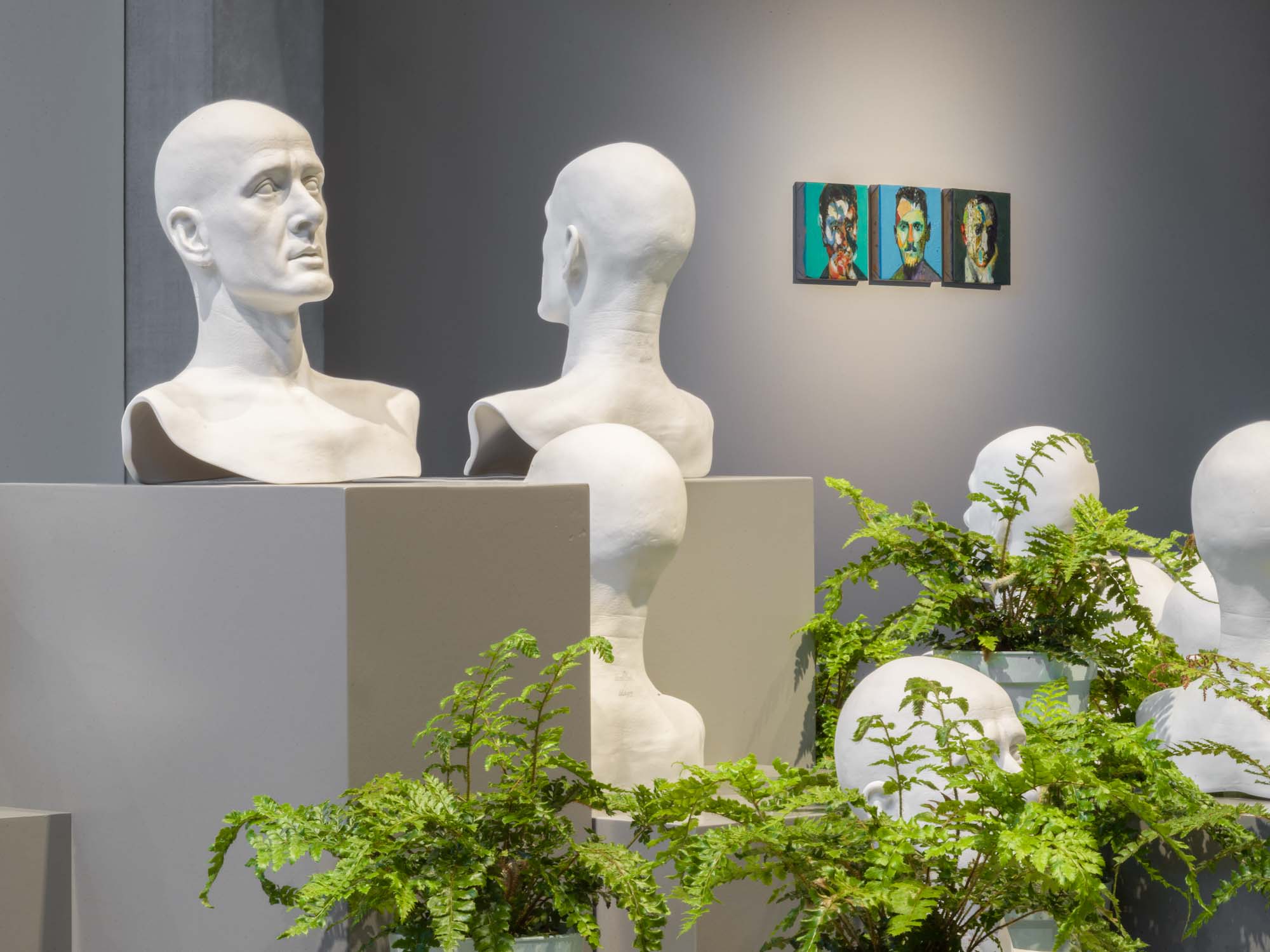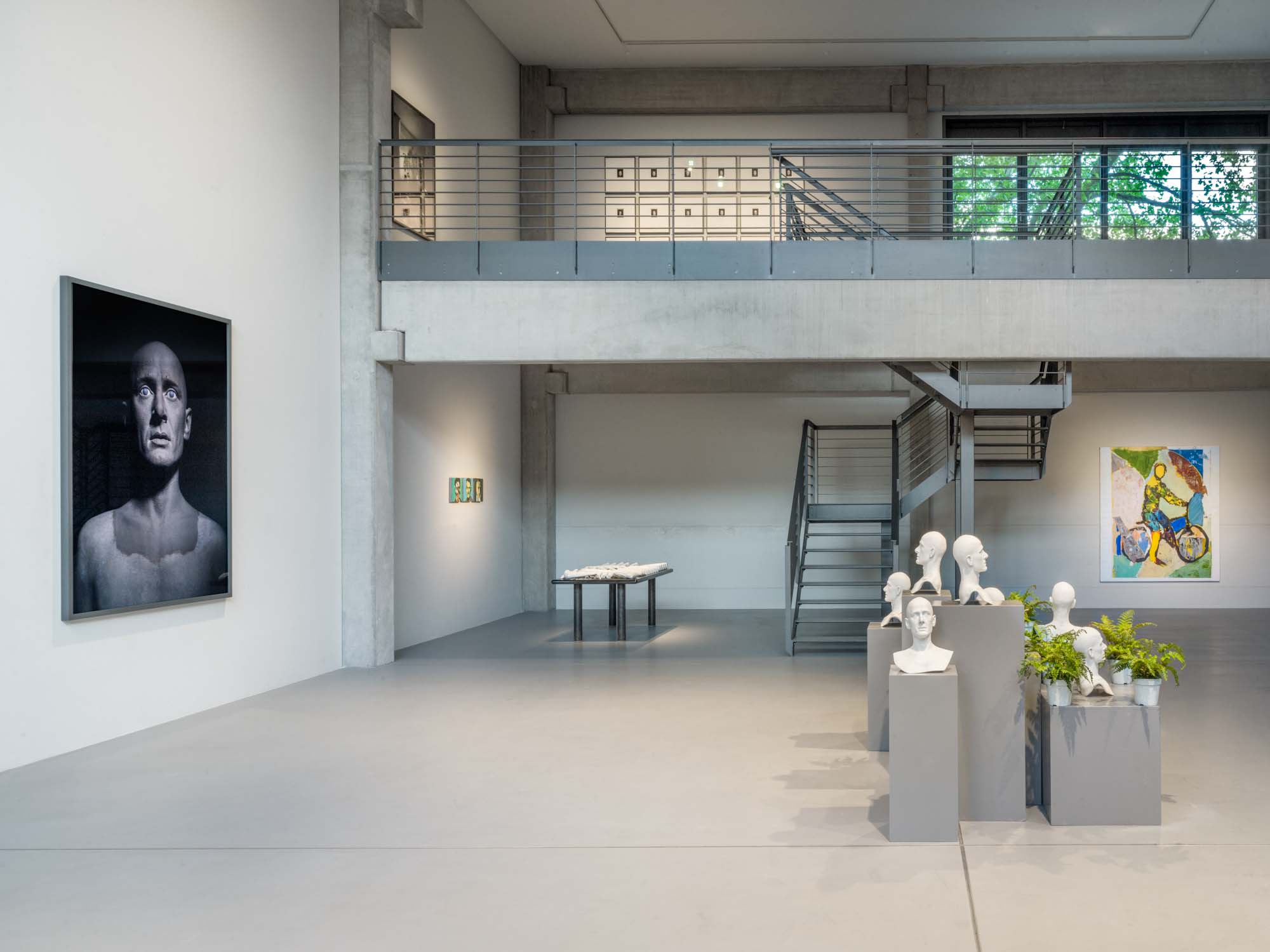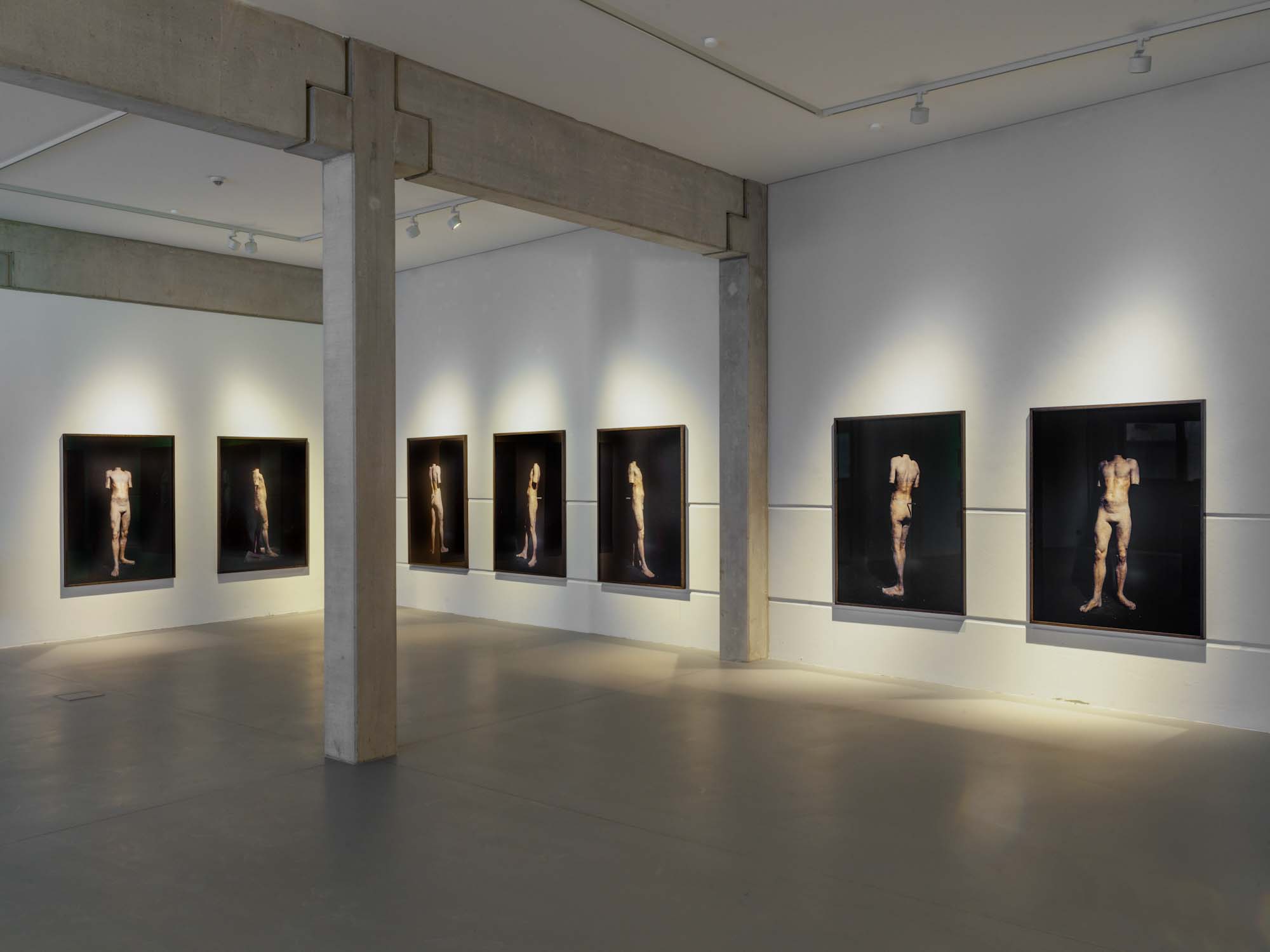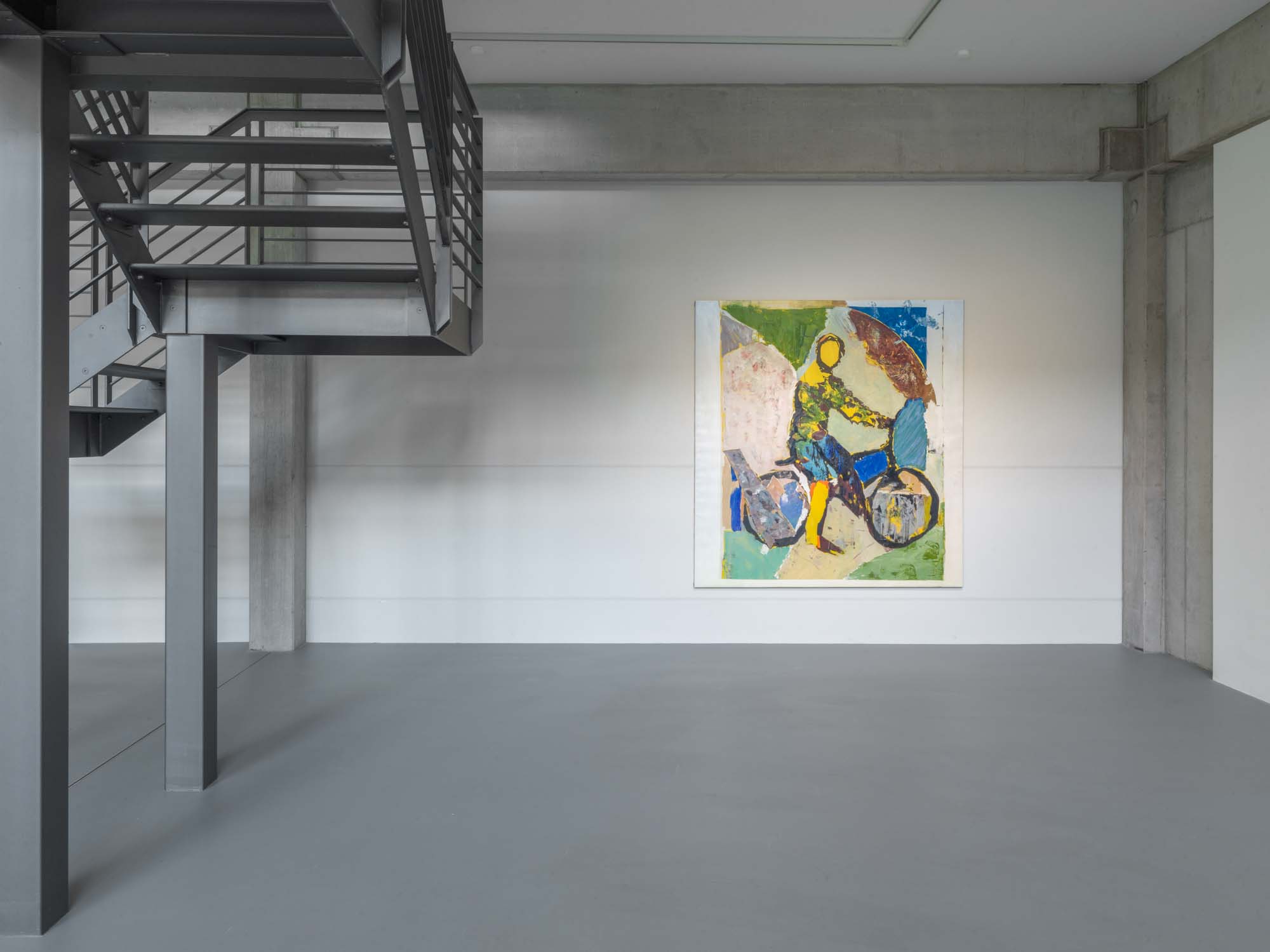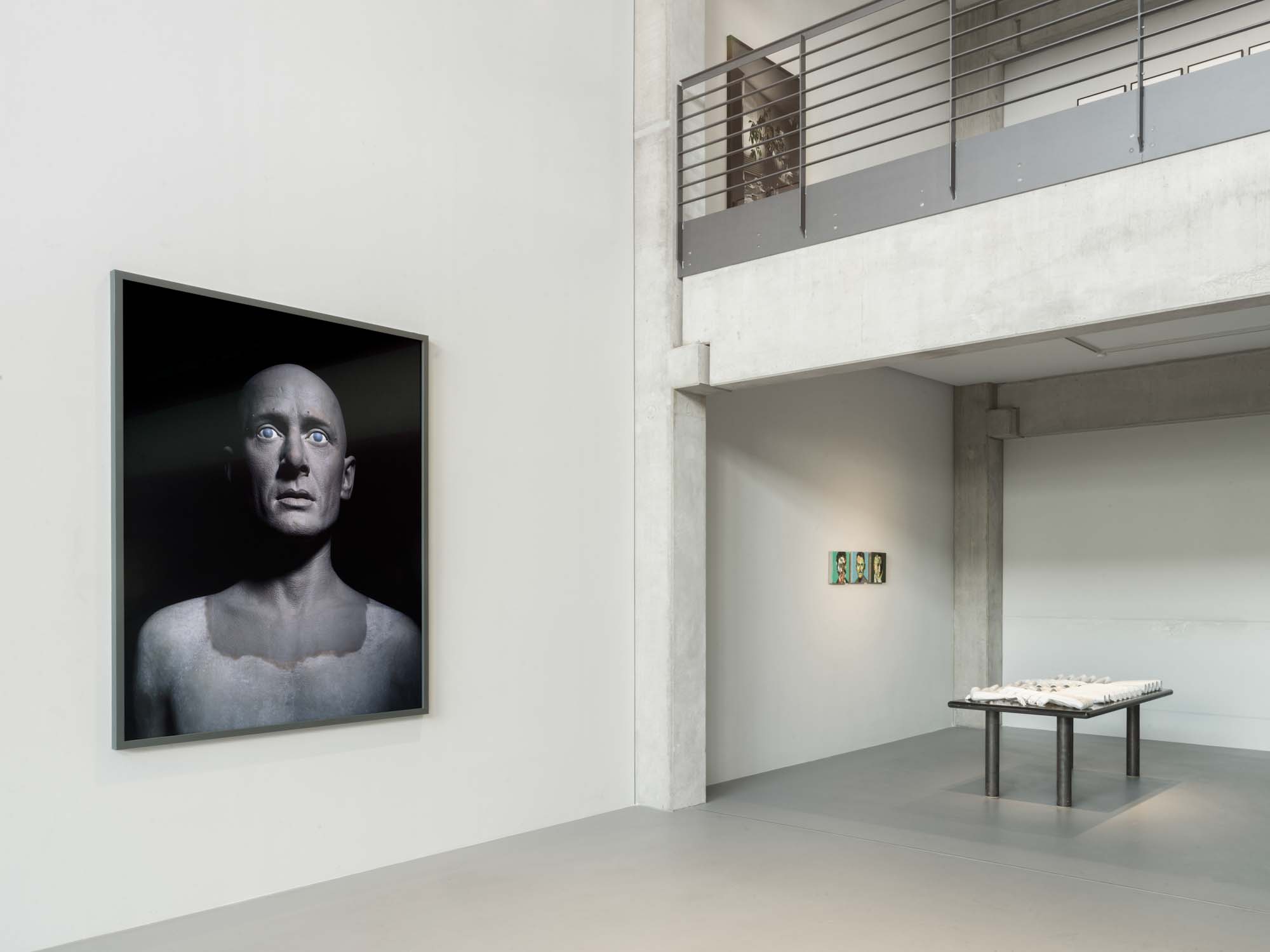Group exhibition „Vladimir & Estragon“
Andreas Mühe and Emmanuel Bornstein
18. May – 12. July 2020
History and memory are omnipresent here. As soon as you enter the exhibition, you come across Adolf Eichmann, the organiser of the Holocaust, in a painting by Emmanuel Bornstein. Right next to it, Andreas Mühe engages in a kind of archaeology of his own existence. A smashed, hollow-eyed clay mask of his face emerges from the black surface of a large photographic work, as if it had been found centuries later in an excavation field. And a historical photograph of the workforce of the Noack bronze foundry in the years after it was founded in 1897 refers in this first triad of images to the place where the "Vladimir & Estragon" exhibition is taking place.
Photographer Andreas Mühe and painter Emmanuel Bornstein work in the same studio in the north of Berlin and are good friends. Now, for the first time, they are realising a joint exhibition at Skulpturenforum Hermann Noack; this has been a "heartfelt idea" for them for some time, as Mühe puts it. To this end, they are each bringing together parts of a body of work from their current oeuvre. Mühe is continuing the highly acclaimed and, for many, disturbing "Mischpoche" project, in which he brought together his family in huge photographic tableaux at the Hamburger Bahnhof in 2019 and had the dead, such as his father Ulrich Mühe, appear in the pictures as lifelike silicone figures. He is now showing porcelain sculptures created in this context for the first time. Bornstein juxtaposes this with an excerpt from his allusive portrait cycle "Another Heavenly Day", complemented by three large paintings from the "Father Figure" series. The exhibition is organised by Avitall Gerstetter and Samuel Urbanik, who are committed to making Jewish culture an authentic, important part of Berlin society through their Salon Avitall and other activities.
History and its traumas, life and death, memory and forgetting, the German actor and theatre-maker dynasty of Andreas Mühe, the Frenchman Emmanuel Bornstein, who also comes from a theatre family and in his pictures repeatedly - sometimes openly, but mostly only as a foreboding association - allows the Shoah to appear, to which many of his ancestors fell victim; finally, the recourse to the "absurd" theatre of Samuel Beckett: a lot of heavy material comes together. However, the exhibition is anything but overloaded, as the two artists lay out reduced traces that leave much open, do not proclaim any messages, but offer starting points for very heterogeneous reflections. The same applies to Vladimir and Estragon in the exhibition title. The two tramps from "Waiting for Godot" may give rise to many associations, such as the artists' friendship or their origins in theatre families, but at the same time the reference to the main characters in Beckett's play, in which nothing moves forward and the great indifference of humanity is revealed, invites a wide variety of interpretations.
Mühe is working with installations for the first time in the exhibition. In preparation for the "Mischpoche" project, he created clay sculptures of his father Ulrich Mühe and his second and third wives Jenny Gröllmann and Susanne Lothar, all actors who have died in the last 15 years (Mühe's mother is the director and theatre manager Annegret Hahn). He also modelled two grandfathers and a grandmother. These clay models were used to create life-size silicone figures - hyper-realistic down to the last detail - with which the dead mingle with the living in the group photographs of the paternal and maternal families with an almost surreal naturalness. Mühe had some of the preparatory clay models cast and fired at Rosenthal in Selb. Now the white bust of Ulrich Mühe stands in the room in nine identical copies on plinths. Like photographs, the porcelain sculptures can potentially be produced in an infinite series, which is also the theme here: the work of art in terms of its reproducibility. A large photograph of the actor's grey clay model, which no longer exists, is a reminder of the creation process. Elsewhere, three dozen forearms from the family's body reservoir are neatly lined up on a table.
It is not easy to understand what is actually happening here. It is certainly a personal memento mori, Mühe's memory of people he has lost. But the artist does not allow private pathos to arise, instead he reflects with the means of art. He arranges a conceptual setting, creates a picture-in-picture situation that is very artificial, even cool, and at the same time has a lot to do with Mühe's characteristic approach to "German" themes in its auratic mood. All of Mühe's photographs are staged, which also has something to do with his family's theatre background. And when he now devotes himself to a very personal context, he takes this staging one step further and intensifies the question of what photography can actually convey. He does not exclude himself. While he "brings back" the dead of his family into an artificial existence, he shows the decay of the clay mask of his own face in a whole series of photos. Basically a classic motif of transience, which appears as cool as it is ghostly in this staging.
Bornstein has been working on the portrait series "Another Heavenly Day" since 2014. Around 70 pictures in the same format (30 x 30 cm) have now been created, and this will continue. Noack has 30 works on display, 16 of which the painter created especially for the exhibition. Family also plays an important role in his work: very directly, when he depicts his father or grandfather; but mostly more indirectly, when the Holocaust and Nazi rule are alluded to. However, this is never shown explicitly. As with Mühe (albeit in a completely different visual language), certain types of people appear, moods emerge, everything remains ambiguous. Bornstein works from photographs and never names who he is painting. That is not the point, nothing should be certain, they are starting points for stories and feelings that develop in the viewer. When asked, Bornstein does name a few figures who appear in the exhibition: Bertolt Brecht, the Nazi criminals Adolf Eichmann, Klaus Barbie and some notorious concentration camp guards, the football player and murderer Aaron Hernandez, the performance artist Ulay, Pussy Riot, but also people from the private sphere. "They all play a role model role in some way, for better or for worse," explains Bornstein. "Ultimately, it's always about the nature of human beings, about what people do to other people."
Bornstein's faces are extremely haunting, not because he shows them in a lifelike way, but because he appropriates them with heavy brushstrokes, torn areas of colour, raw fades and other painterly tricks. He literally penetrates them, at times it seems as if he is fighting with them to fathom their essence, to get to a core that no one has yet recognised. "For me, the canvas is like a human skin," says Bornstein. When he paints people, it is about existence, about life. His painting style moves beyond all fashions, somewhere between abstraction and figuration. Some pictures look like collages, others seem to dissolve in hydrochloric acid. Memories are important, both personal and historical. He deals with them full of emotion, and the expressive, sometimes ecstatic painterly language is his medium for expressing his feelings. This also applies to the three large paintings from the "Father Figure" series. A man on a bicycle is actually his father, on another canvas Beckett appears with glasses and a questioning look. What do we actually know? Can we trust what we see? Andreas Mühe and Emmanuel Bornstein's approaches to finding answers are not as different as they might initially seem.
to the exhibition: Vladimir and Estragon
